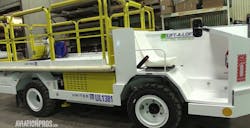Marketing tool "The runway was a good investment for the future of the St. Louis area," says Deputy Airport Director Gerard Slay.
Not needed, some say "I almost wish I could say I'm shocked, but all along we knew the number of flights (was) going down," says Sara Barwinski, whose home in Bridgeton was razed for the runway.
---
Lambert Field's new runway -- the one that cost $1.1 billion and displaced thousands of north St. Louis County residents -- is getting little use and therefore generating fewer noise complaints than critics predicted.
Between its April 13 opening and Sept. 30, the runway handled about 5 percent of departures and landings, or about 6,600 operations, airport data show. Most of those flights are Delta, Continental, and other air carriers with gates in Concourse A.
The airport has three main runways. The busiest, closest to the terminals and longer than the other two main airstrips, handled nearly 50 percent of the 126,700 departures and arrivals.
The new runway's distance from most other gates is the primary reason few pilots are using it, said Brad Rosenthal, an air traffic controller at the Lambert tower who directs pilots where to depart and land. Its distance from the East Terminal makes taxi time from the 9,000-foot-long strip costly and time consuming for Southwest Airlines, the airport's second-largest carrier. The same goes for air carriers in the C and D concourses, Rosenthal said.
"It's all based on what provides the best service to each individual user," he added. "The commercial jets that fly for American, they also park on that end of the airport, so they tend not to use it."
The runway was built to reduce congestion and weather-related delays. But in the last six months, the most expensive construction project in St. Louis history has mostly been used as a marketing tool. Lambert officials are banking on the hope that it will help lure new carriers and restore flights lost in late 2003, when American Airlines cut its St. Louis schedule by half.
No congestion
MidAmerica Airport in Mascoutah also was built in response to Lambert's bursting-at-the-seams condition in the 1990s. These days, it has only four commercial flights a week.
Congestion at Lambert hasn't been a problem since the Sept. 11, 2001, terrorist attacks. Flights and passengers have been steadily increasing since American's cutbacks, but slowly.
"The plan was to provide us with additional capacity for the amount of traffic we had at the time," Deputy Airport Director Gerard Slay said. "Right now, it's still attractive to new entrant carriers, when we go out and try to market additional air service."
Slay said the runway has helped Lambert get a few nibbles. "The runway was a good investment for the future of the St. Louis area," he said.
When the federal government approved the runway plan in 1998, Lambert was buzzing. It was TWA's primary hub. Strong storms or heavy fog restricted landings to one of two parallel runways, which were built too close together to handle simultaneous arrivals during bad weather. The delays would impact flight times nationwide and cost airlines millions of dollars.
Since April, visibility has not forced one of Lambert's runways to close. The July 19 storm resulted in a ground stop, meaning no airplane could take off or land on any runway.
"It really does not provide much benefit at all right now," Rosenthal said of the new strip. "We would find creative ways to use it if we had the traffic we once had. It just doesn't make a lot of sense right now."
Nevertheless, airlines began paying part of the expense in July. Air carriers at Lambert are responsible for 23 percent of the runway's costs. This amounts to a $1 surcharge for every passenger who boards at Lambert. The rest of the bond debt is being financed by the airport and the Federal Aviation Administration, from funds made up of airport user fees.
Lost in vain?
Sara Barwinski, whose Bridgeton home was among 2,000 structures razed for the new runway, said its 5 percent usage makes her wonder if her neighborhood was lost in vain. The airport still has 22 parcels left to buy in the runway buyout area. Of those, 13 are in condemnation.
Barwinski, who protested the runway by picketing the airport in the 1990s, long argued that the project was not needed.
"I almost wish I could say I'm shocked, but all along we knew the number of flights (was) going down," she said.
Runway opponents in St. Charles argued that a new runway would bring airport noise to their living rooms. But the most complaints this summer, between June 1 and Oct. 15, came from north St. Louis County, according to airport call data.
Bridgeton had 84 complaints from 32 residents. St. John had 32 complaints from 13 residents.
In St. Charles, 11 complaints came from eight households.
Lambert has microphones at 20 noise-monitoring locations, stretching from the intersection of Belwood and Kirkland drives in Normandy to Blanchette Park in St. Charles. Officials expect to know after May 2008 how much the new runway has raised noise levels.
Rosenthal said use of the new runway should pick up this winter. Snowy weather often reduces visibility. It's in those conditions that one of the two older runways sometimes closes.
Even so, closing one runway doesn't have the impact that it did in 2001, when its number of boardings made Lambert the 11th-busiest airport in the country, according to the U.S. Bureau of Transportation Statistics. These days, Lambert ranks 31st.
"If it went away tomorrow, we wouldn't miss it," Rosenthal said of the new runway. "It shouldn't need resurfacing for many, many years."
Copyright 2005 LexisNexis, a division of Reed Elsevier Inc. All rights reserved.
Terms and Conditions | Privacy Policy
News stories provided by third parties are not edited by "Site Publication" staff. For suggestions and comments, please click the Contact link at the bottom of this page.





